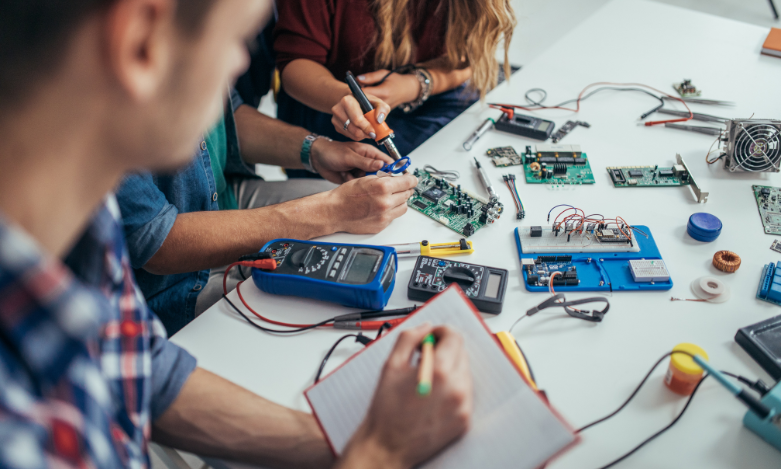Hydraulic Control System for Automotive Component Shaping
- May 3, 2023
- 4 min read
Updated: Mar 27, 2024
*As Featured on NI.com
Original Authors: Adrian Short, Omiga Technology Limited
Edited by Cyth Systems

The Challenge
We set out to improve the manufacturing process for high-volume components for the automotive industry, whilst maintaining accurate position control and efficient operation. This would empower us to replace mechanical systems, which can be expensive to reconfigure for new products.
The Solution
We used the CompactRIO platform to automate the manufacturing process, whilst providing high-accuracy position control and informative user interactions for the operation and configuration of new automotive products, which resulted in significantly lower operational cost.
Innovating Automotive Body Shaping
Most people are unaware of the complex technologies required to make body components on today’s modern cars, such as car doors or trim for windows and sills. Generally, these items have a highly polished finish and need to be formed into complex shapes with unusual bends. This requires careful manipulation and forming of the material to ensure no material stress lines and wrinkles form.
The conventional controllers used for shaping automotive body parts offer limited accuracy, and reconfiguring the machines to accommodate new parts costs time and money. We needed a flexible and cost-efficient system to improve the process. An automotive manufacturer approached Omiga Technology to develop such a system. The resulting machine (Figure 1) stretch bends material to form automotive body parts, accommodating precise positioning and force to apply to the material at specific points in the forming process.
Left: Automotive Body Parts Shaping Machine, Right: Multi-Axis Head Unit With the LabVIEW Real-Time Module and FPGA.
The control system architecture includes three CompactRIO devices for sensing and control and a PC user interface. The CompactRIO devices and the PC connect to a local network to provide the communication backbone for the system. Synchronizing the controllers is critical to the forming process, as it ensures each actuator moves to the right position at the right time. To achieve tight synchronization between each of the CompactRIO controllers, an allocated master CompactRIO transmits a digital clock signal to each of the other CompactRIO devices. Once clock synchronization occurs, the movement profile of each axis is downloaded to the individual CompactRIO devices to generate the required set points for each control loop. We generate the data stream for each control loop on the real-time processors, thereby minimizing network traffic while providing smooth axis movement.
We achieve controlled movement using servo-controlled actuators (Figure 2), in which we use CompactRIO to monitor and control the position. We fit each CompactRIO with multiple C Series modules to provide analog I/O, digital I/O, and the associated signal conditioning, and to interface with position sensors, pressure sensors, servo valves, SSI encoders, and oil control solenoids. We synchronize the acquired data and control signals in operation to provide the required form and load for the manufacturing process, which results in an accuracy of 0.01 mm and 0.01 degrees over the working range of 1,200 mm and 95 degrees of rotation.
The user interface delivers real-time graphing (Figure 3) and feedback to the operator of the machine status and profile performed. We made the system configurable for many product variants, so we needed the ability to develop stretch bend profiles for efficient operation. Therefore, we developed a teach mode (Figure 4) to control each axis independently or as a group. We can move each axis at a defined rate either to a known position or via jog controls. Upon achieving the desired positions on each axis, we can synchronize all axis and perform a test move at a reduced speed, which we can adjust to the optimal operational rate after completing setup.
We can store movement profiles and product configurations for each product variant and present them through a simple selection screen when in production mode.
Constructing the Multi-Axis Control System Using LabVIEW
The development of the multi-axis control system focused on three core areas: accuracy, flexibility, and speed. We used LabVIEW to design a digital control system that broadened the functionality of our customers’ existing systems, whilst improving accuracy and setup time.
We designed the actuator control algorithms to produce smooth movements, with definable ramp and roll-off waveforms, to achieve accurate movement up to 200 mm/sec with no overshoot. We synchronized all actuators with envelope alarms, which detect if an axis could not meet the required movement and perform a controlled stop to protect the machine and product.
NI technology is at the heart of the control system. We used LabVIEW to program both the real-time processor and the integrated FPGA. This helped us drive the servo system because it can generate the required speed for controlling and returning data. NI offers us the best controllers on the market for operating actuators at high speed, while maintaining the high accuracy required for specialist production machines.
The Impact of Our Multi-Axis Shaping Machine
The multi-axis control system applies a constant force while forming the material to a high degree of positional accuracy to mate with other components on the vehicle. The characteristics of the material and form required make the teach screen functionality valuable, as operating engineers can trial the forming process and change parameters with the system live. Once proven, they can trial the profile in production mode and further adjust to optimize speed without changing the forming process.
Following a development and production program that lasted just four months, we tested the machine at our customer’s manufacturing plant. We verified a user-friendly system setup and configuration and an initial 10 percent reduction in cycle time. Given the time to adjust to the new machinery, we expect further savings in cycle time and configuration cost.
Original Authors:
Adrian Short, Omiga Technology Limited
Edited by Cyth Systems








